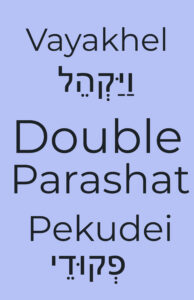
When you Choose Shabbat, you choose to learn that every Shabbat is different and special. This week I learned about Parashat Vayakhel (וַיַּקְהֵל) and Parashat Pekudei (פְקוּדֵי), the 22nd and 23rd weekly Torah portion in the annual cycle of Torah readings, as well as the last two readings from the Book of Exodus. I also learned that the lunisolar Hebrew calendar contains up to 55 weeks, the exact number varying between 50 in common years and 54 or 55 in leap years. According to Wikipedia, in leap years (for example, 2019, 2022, 2024, and 2027), parashah Vayakhel is read separately. In common years (for example, 2018, 2020, 2021, 2023, and 2026), parashah Vayakhel is usually combined with the next parashah, Pekudei, to help achieve the number of weekly readings needed (although in some non-leap years, such as 2025, they are not combined).
According to Wikipedia, Vayakhel (וַיַּקְהֵל), Exodus 35:1 through 38:20, contains 6,181 Hebrew letters, 1,558 words, 122 verses and makes up 211 lines of the Torah scroll . In contrast, Pekudei (פְקוּדֵי), Exodus 38:21–40:38, contains 4,432 Hebrew letters, 1,182 words, 92 verses and 159 lines of Torah.
Vayakhel (translated as “He Assembled”) opens as G-d commands the Israelites to observe the Sabbath. Moses asks for material donations for the building of the Mishkan (Tabernacle) and the people donate. A group of artisans designated by G-d begin to build the Mishkan and its vessels.
Rabbi Michael D Klein of Temple Torat Emet offers his insights on this week’s double Torah reading, Vayakhel and Pikudei:
“A very interesting scenario occurs in this week’s double Torah portion of Vayakhel and Pikudei. The Nesiim (Princes of each tribe) are given the commandment to supply all the materials required to build the Mishkan. They assumed, wrongly, that Klal Yisroel some of whom had been involved with idolatry, would not step forward and provide the needed support in materials, money, and skilled craftsmanship needed to construct the Mishkan. Instead, not only did all of Israel step forward to contribute, the Midrah relates that they sent their children to bring their money to Moshe for the construction process. Why? Rabbi Gavriel Zeev Margolis suggests that this was to teach Bnai Yisroel about the essential message of Tzedaka. In Proverbs 22:6 we are told, “Educate a child according to G-d’s way so that when he grows up he will not turn away from it”. In the Shema, it states, “you shall teach them diligently to your children”. If we teach children the essential value of giving selflessly to others, they will carry this lesson forward for their entire lives.
If we combine this lesson with the essential lesson of the special portion of Shabbat Hachodesh we are taught, “and you shall relate the story of the miracles of liberation to your children on that day”. So much emphasis is placed on the Torah ensuring that our children and future generations receive and understand the lessons of awareness of Mitzvot and generosity of spirit. It is not enough to tell our children to do the mitzvot. We must actively involve them in performing them. They learn from the example we set. If we teach a child about the importance of Shabbat or the Holidays and then ignore observing them we are failing to teach by example. Our children observe our actions and thus learn which values are most important in bringing Torah into our lives. This means that every Jewish parent has the obligation to learn the mitzvot and teach them to their children verbally and by action. This is how the values taught in Torah are transmitted to every generation!
Questions to Consider:
- Which of the Holy articles were donated and assembled only by the women of Klal Yisroel?
- How was Betzalel related to Moses?
- What was Moses’ contribution to the construction of the Mishkan?
- Where were the Luchot (Stone Tablets) placed before and after the construction of the Mishkan?
- Why was Moses reluctant to enter the Tent of Meeting through the Shechina of G-d?“
Rabbi Michael D. Klein attended Yeshiva College of South Florida and served as Torah Reader, Hebrew teacher, Chazzan and spiritual leader of various synagogues throughout South Florida. In January 2015 he became Ritual Director, Bnai/Bnot Mitzvah instructor and 7th grade Hebrew instructor for Temple Torat Emet of Boynton Beach. In October 2019 he was accepted into an accelerated track and received his shicha from Yeshiva Adath Wolkowisk and has been the Rabbinic leadership of Temple Torat Emet since August 2020. In September of 2022 he was appointed Rabbinic and Spiritual Advisor of the Florida Region of FJMC.
Choose Shabbat; choose to celebrate, to light candles, sing songs and learn a little Torah.
This moment of Jewish Learning is brought to you by the Florida Region of the Federation of Jewish Men’s Clubs (FJMC). We are part of a confederation of over 200 Jewish Men’s Clubs and Brotherhoods representing over 20,000 members across the United States, Canada, Latin America, and beyond. Learn more about how your Jewish Men’s Club or Brotherhood can affiliate with the FJMC at: https://www.fjmc.org/content/affiliating-fjmc.
The Florida Region of FJMC serves the needs of affiliated Men’s Clubs and Brotherhoods throughout the State of Florida. Get to know more about the FJMC Florida Region and our growing network of Jewish Men’s Clubs and Brotherhoods at www.floridaregionfjmc.org and please visit and LIKE our Florida Region FJMC Facebook Group at www.facebook.com/FloridaRegionFJMC.







